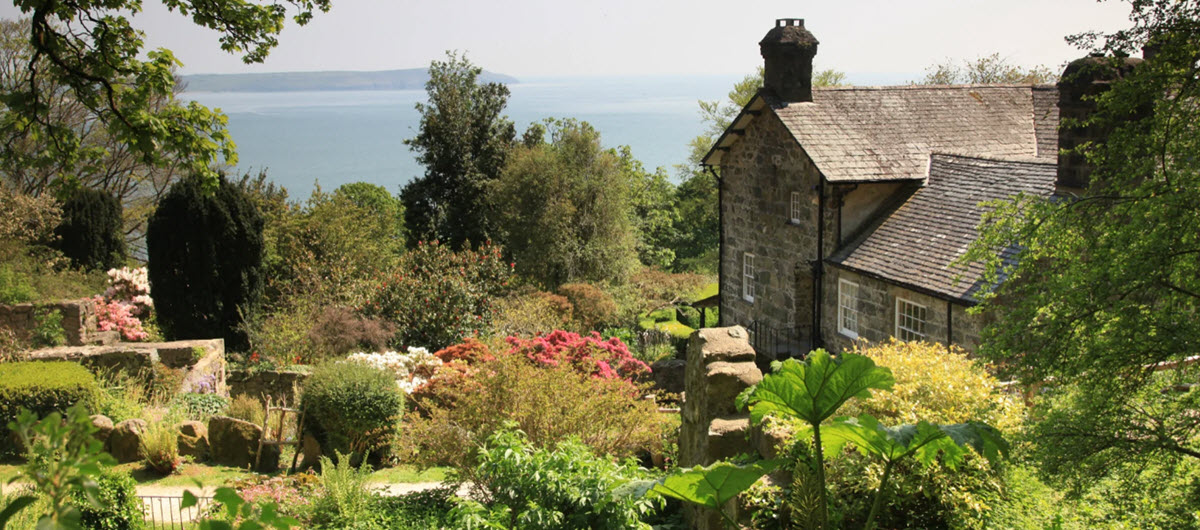Contents
Plas yn Rhiw is a manor house built on the Llŷn Peninsula of northwestern Wales during the early 17th century.
The house, which is of Tudor/Georgian style, sits on a garden that´s less than one acre in size, but the estate also includes several acres of wooded land. The garden of Plas yn Rhiw is the only organic National Trust garden in Wales. The estate contains several Grade II listed buildings, including the manor house itself, a detached cottage and an old cartshed.
Plas yn Rhiw was privately owned until the 1940s, when the three Keaton sisters donated the estate to the National Trust in memory of their parents Constance and William Keating. The three sisters lived in the manor house until their death.
The history of this manor estate goes back much longer than the 17th century, and the area is believed to have been inhabited and strategically important for thousands of years.

Where is Plas yn Rhiw?
Plas yn Rhiw is a part of the small village Y Rhiw, which is located on the southwestern tip of the Llŷn Peninsula in Gwynedd in northwestern Wales. Situated at the base of Mynydd Rhiw, the estate overlooks the beach of Porth Neigwl and Cardigan Bay.
Coordinates: 52.8225°N 4.618889°W
Buildings
The main building
The main building was constructed using large stones. At certain points, the walls are 6.5 feet deep.
Naturally, changes have been made over the centuries. As early as the 17th century, the original building was given a third storey and a lateral extension.
In the late 1930s, the Keating sisters (Eileen, Lorna and Honora) restored the house, with advice from architect Sir Clough Williams-Ellis. Among other things, they made the grey stones visible again by removing the Regency style stucco that had been added to the walls circa 1816.
Gardener´s cottage
Adjoining the manor home is a two-storey cottage that used to be the home of the gardener. Nowadays, it is available for rent. It includes kitchen, sitting room/dining room, fireplace, bedrooms and a bathroom.
Examples of other buildings
- A Grade II listed cartshed
- A summerhouse
- An old mill next to a stream
Grounds
Garden
The garden is sheltered by the house and terraced into the slope, which keeps it safer from prevailing winds. Hedges are used to divide it into comparments, and the whole garden is accessible via grass paths and cobbled ones. Examples of flowers and plants grown in the garden are rhododendron, magnolia, azalea, snowdrops and bluebells.
Woodlands
When the estate was given to the National Trust, it included 400 acres of countryside. Since then, the trust has added 150 acres of surrounding woodland.
History
One of the earliest reports of a house located close to the present manor house is from the the Medieval period. The Gwynedd Royal Dynastay established themselved in the region around the 5th century, and in the 9th and 10th century they successfully fought off invasion attempts by both Vikings and Saxons. Meiron Goch (a great grandson of Rhodri the Great, first king of all Wales, who ruled here in the 9th century) is reported to have built a house close to the present Plas yn Rhiw in the 10th century.
In the 16th century, The Caernafon Quarter Sessions Calendar notes that there is a manor house called Plas yn Rhiw in the village of Rhiw. The residents of the manor house did not have a surname back then; it wasn´t until later that the family adopted Lewis as their surname.
In the current manor house at Plas yn Rhiw, and inscription dated 1634 was found at a window and attributed to John Lewis, who was presumed to be the owner of the house at that time.
